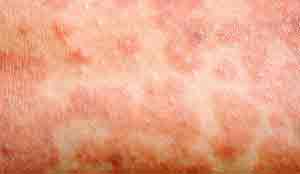Measles
Measles is a highly contagious airborne virus that lives in the nose and throat mucus of an infected person. The symptoms of measles generally appear about seven to 14 days after a person is infected, but has a range of onset from 7-21 days.
Measles is a highly contagious airborne virus that lives in the nose and throat mucus of an infected person. The symptoms of measles generally appear about seven to 14 days after a person is infected, but has a range of onset from 7-21 days.
Measles typically begins with:

Two or three days after symptoms begin, tiny white spots (Koplik spots) may appear inside the mouth.
Three to five days after symptoms begin, a rash breaks out. It usually begins as flat red spots that appear on the face at the hairline and spread downward to the neck, trunk, arms, legs, and feet. Small raised bumps may also appear on top of the flat red spots. The spots may become joined together as they spread from the head to the rest of the body. When the rash appears, a person’s fever may spike to more than 104° Fahrenheit.
After a few days, the fever subsides and the rash fades.

In 2019, the United States experienced the highest number of measles cases since 1992, with 1,274 cases from 31 states reported to the CDC. This is the greatest number of cases since measles was declared 'eliminated' in the U.S. in 2000.
Measles can spread to others by breathing in aerosolized virus from infected people who are breathing, talking, coughing and sneezing. Also, measles virus can live for up to two hours in an airspace where the infected person was present. If other people breathe the contaminated air or touch the infected surface, then touch their eyes, noses, or mouths, they can become infected. Measles is so contagious that if one person has it, 90 percent of the people close to that person who are not immune (immunized) will also become infected.
Infected people can spread measles to others from four days before through four days after the rash appears.
Measles can be prevented with the MMR (measles, mumps, and rubella) vaccine. One dose of MMR vaccine is about 93 percent effective at preventing measles if exposed to the virus, and two doses are about 97 percent effective.
No treatment can get rid of an established measles infection. However, some measures can be taken to protect vulnerable individuals who have been exposed to the virus.